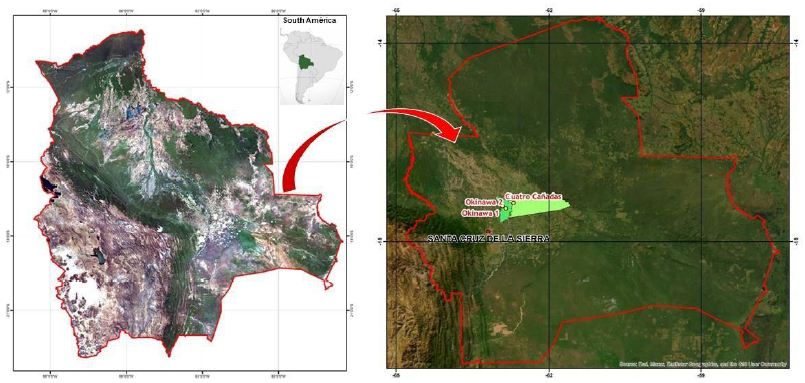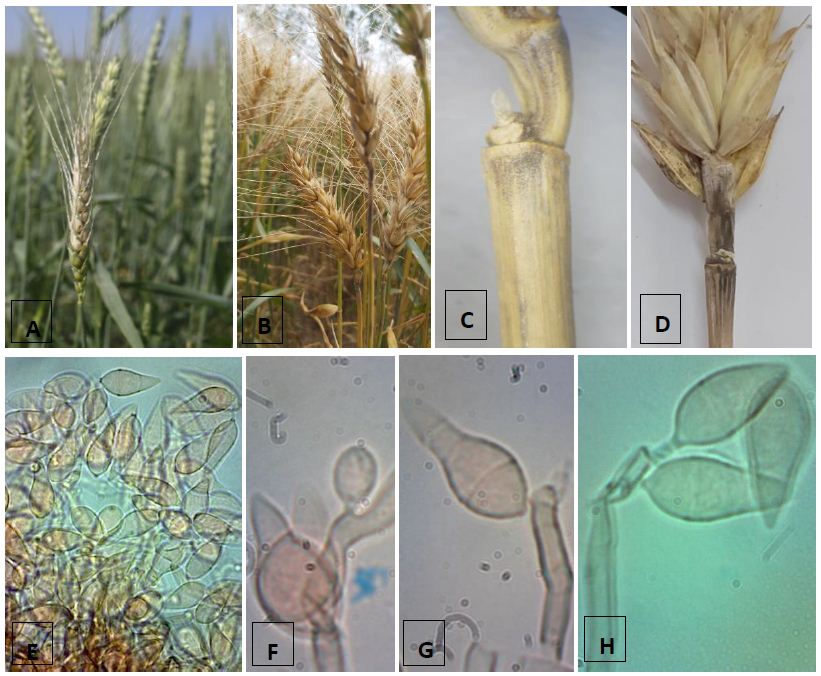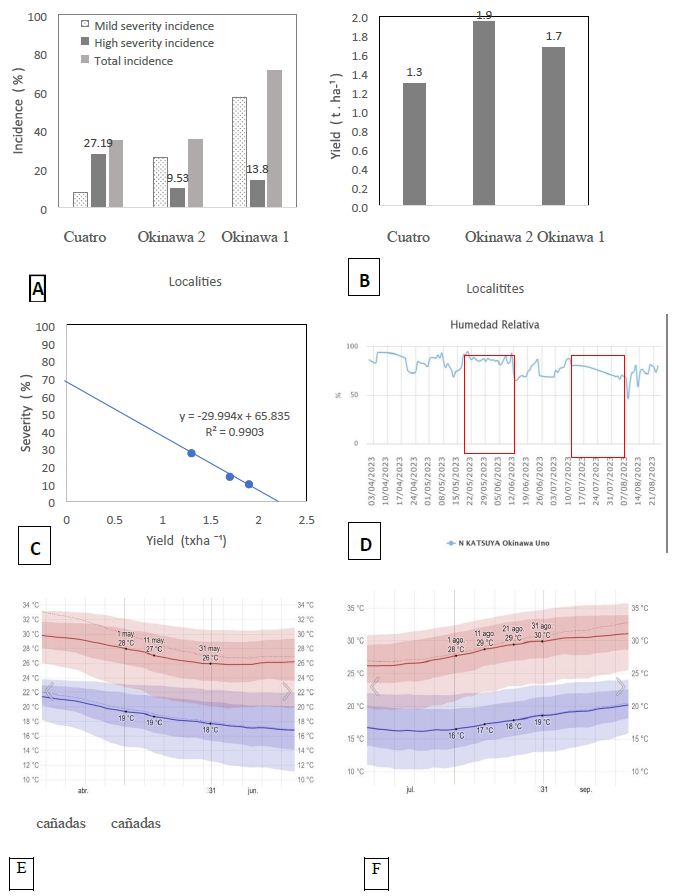DOI: 10.31038/MIP.2024522
Abstract
Cultivation of wheat (Triticum aestivum L.) in the lowlands (270 meters above sea level) tropics of Santa Cruz department is a strategic rotation crop and is the most important bread wheat producing region in Bolivia. However, phytosanitary limitations such as fungal diseases are a problem current. Pyricularia disease of wheat, registered in 1996 in this region, is one of the main limitations. Damage to production has been recurring in recent years and, according to reports, can cause severe reductions in production. Research objectives were: i. Identification of Pyricularia fungus from symptoms at the base of the spike rachis; ii. Estimate the incidence of Pyricularia disease, and, iv, Yield estimate (t.ha-1). One m2 was collected samples (with three repetitions) from three localities in the integrated north, Okinawa 1, Okinawa2, and Cuatroañadas, from the same municipalities and Warnes and Nuflo de Chavez provinces, respectively samples were taken to the plant pathology laboratory and processed for the Pyricularia fungus identification, symptomatology description, incidence and yield estimation. Results show that Pyricularia disease is caused by the fungus Pyricularia oryzae, in the field, it occurs with different levels of incidence and severity, being the highest in the localities of Okinawa 1 (57%) and Okinawa 2 (25.8%). Obtained yields show that, being affected by the disease, they are acceptable averages for the region. Correlation analysis it, under the relative humidity conditions of the 2023 winter crop, reaching 60% severity, the disease can cause drastic losses in wheat production.
Keywords
Yield losses, Mitosporic fungi, Intensity disease
Introduction
In the lowlands tropics of Santa Cruz department, the cultivation of wheat (Triticum aestivum L.) began to expand between 1985-1990 (INE, 2024). According to official statistics, since 1984, it has grown from 6,400 hectares to 120,000 to 140,000 hectares in 2022 [1]. Inter-Andean Cochabamba valleys were the main suppliers, in ’80 years, of semi-dwarf wheat varieties seeds such as “Chane and Saguayo” varieties for the east of Santa Cruz [2]. Subsequently, the lowland region of Santa Cruz began a self-sufficiency of improved wheat seeds supported by the Tropical Agriculture Research Center (CIAT), the Association of Oilseed and Wheat Producers (ANAPO), and private companies. Until then, the main diseases causing wheat production losses in the inter-Andean valleys (2000-3000 meters above sea level) of Bolivia and globally were considered traditional diseases, such as stem rust (Puccinia graminis tritici), leaf rust (Puccinia triticina) and stripe rust (Puccinia striiformis), Septoria leaf and glume spots (Septoria tritici and Septoria nodorum) and spot blotch (Cochlibolus sp.). On the other hand, for the eastern. Santa Cruz region, it was considered that they could be the same due to the “introduction” cultivation condition. However, later, in 1996, Barea and Toledo, it was reported by Santa Cruz Department of Bolivia as Pyricularia wheat blast disease [3]. So, this report helped guide subsequent phytosanitary research for wheat. At present, Pyricularia blast wheat is a generalized and important disease in wheat production in the Santa Cruz lowland tropics.
Wheat blast disease was first discovered in the state of Paraná, Brazil in 1985 (Igarashi et al., 1986), Since then, has become a major disease across central and southern Brazil and is now well established in tropical regions of South America [4]. At present wheat blast disease is not restricted to the tropical and sub-tropical regions of South America (north-eastern Argentina, lowlands of Bolivia, central and south-central Brazil, and Paraguay) only [3,5,6]. According to Metha (2014), the grain yield losses caused by Pyricularia blast can vary from very low to almost 100 % and the highest losses occur when the fungus attacks the rachis at the base of the spike affecting total or partial grain filling depending upon the time of infection. In Bolivia, in 1996, infections of wheat blast resulted in a loss of almost 80 % of the production, in 1997, the disease was devastating in the early seeded fields, causing a 100% loss [3]. The highest losses occur when the fungus attacks the rachis at the base of the spike thereby limiting the development of the grains and killing the spike completely [4]. Actually, after more than 27 years since the Pyricularia blast disease emerged, new varieties with genetic resistance, new management strategies, and new technologies have been introduced, but, the disease continues are cause losses in production. Research objectives were: i) Symptoms Description, ii) Incidence of Pyricularia disease estimation, and, iii) Yield estimation (t.ha-1).
Material and Methods
In August 2023, wheat sampling was carried out in commercial production plots in the harvest phase (‘Motacu’ variety) in two winter (April-August) wheat-producing municipalities in the lowlands Santa Cruz department. Localities were: Okinawa 1 (262 meters above sea level, 20K 510442 and UTM 8091262) and Okinawa 2 (271 meters above sea level, 20K 517888 and UTM 8085843), in the Okinawa municipality, Warnes Province and Cuatro Cañadas locality (267 meters above sea level, 20k 531485 and UTM 809). 8189) of the same name municipality, Ñuflo de Chávez Province, department of Santa Cruz (Figure 1). Sampling consisted of taking One m2 with three repetitions per plot completely at random. Each sample was cut manually with a sickle at the height of the stem base, was identified, and transferred for processing to the laboratory. Each sample was evaluated independently for incidence of disease according to Campbell and Madden (2011) [% Incidenced (Total diseased plants/total number plants*100)] and severity disease was estimated following an arbitrary criterion consisting into two categories: mild (Figure 2B, C), and high severity (Figure 2D, E). The evaluation was carried out on each stem by the stem for each sample under a stereomicroscope, checking from the base to the top of the spike rachis. Causal agent identification was carried out by mounting in lactophenol solution on the symptom and sign based. Conidiophores and conidia were observed according to the Ellis (1976) criteria, and the yield estimation manually threshing and weighing carried out was.

Figure 1: Wheat sampling areas location, in the north of the Santa Cruz department, Warnes and Ñuflo de Chavez Provinces. Bolivia. Map elaboration: CISTEL. Engineering department. FCAyP, UMSS. Cochabamba, Bolivia.
Results and Discussion
Characteristic symptom of Pyricularia disease, in the field, is a dark brown to blackish spot present at the rachis or base (Figure 2A) and its whitish color spike (Figure 2A, B). Under the stereoscope observed, the severity of disease degrees at the spike base and different spine parts are differentiated (Figure 2B, C, D, E). In the mildest severity degrees (Figure 2B, C), the disease is very little visible to the naked eye; On the other hand, in the more intense coloration degrees, the typical symptoms are evident (Figure 2D, E). At all severity degrees conidia and conidiophores of Pyricularia mass powdery are formed (Figure 2A). Conidiophores are mononematous, slender, strait, geniculate toward the ápex, brown, smooth. Conidiogenous cells are polyblastic, and integrated. Conidia solitary, dry, simple, obpyriform, ob clavate, pale olivaceous brown, smooth, 1-3 septate, hilum protuberant (Figure 2F, G, H) according description to of Pyricularia oryzae [7].

Figure 2: Symptom, sign and causal agent of Pyricularia blast wheat. A: fungus attacks the rachis; B: at the base of the spike at different phenological stage; C: Mild severity; D: High severity; E; Mass Pyricularia conidia; F-G: cell conidiogenuous; H: Conidiophore and conidia of Pyricularia oryzae tipically inserted. Motacu Variety. Santa Cruz, Bolivia. Year 2023.
Pyricularia disease was recorded in the three locations sampling, in different degrees incidence and severity (Figure 3A). Okinawa1 is recorded as the highest incidence (71%), and Cuatro Canadas sector 34% and Okinawa 2 (35%) (Figure 3A). Incidence of severity is highest in Cuatro cañadas locality (27%) followed by Okinawa1 (13.8%) and Okinawa2 (9.5%). With higher grain yields were Okinawa2 (1.9 t.ha-1) then Okinawa1 (1.7 t.ha-1) and Cuatroañadas (1.3 t.ha-1) (Figure 3B). According to INE (2023) and ANAPO (2022), wheat yield average for Santa Cruz is 1.5 txha-1. The yields of the present study are slightly higher than the averages reported by them. However, this could be explained because the data are departmental averages (INE and ANAPO) and, on the other hand, results are on specific localities (Cuatro Cañadas, Okinawa2, and Okinawa1).

Figure 3: A: Incidence and severity of Pyricularia wheat; B: Yield (txha-1) of wheat in different localities of the northern of Santa Cruz, Bolivia; C: Correlation analysis; D: Relative humidity of Okinawa 1 locality; E-F: April-September Tempeature variation, 2023. https://es.weatherspark.com/m/28522/8/Tiempo–promedioen–agosto–en–Okinawa–N%C3%BAmero–Uno–Bolivia#Figures–Temperature. Santa Cruz, Bolivia. Year: winter crop, 2023.
The first severe infections of wheat blast in Bolivia were observed in the lowland Santa Cruz region in 1996 and resulted in the loss of almost 80% of the production (Barea & Toledo 1996). But, yield to this year (1996) was 1.36 t.ha-1 (ANAPO 1996). According to Metha (2014), the grain yield losses caused by Pyricularia blast can vary from very low to almost 100 % and the highest losses occur when the fungus attacks the rachis at the base of the spike affecting total or partial grain filling depending upon the time of infection. A negative correlation is observed for severity vs yield, under the conditions of the present winter 2023 growing season, in Santa Cruz, it can be predicted that reaching a 60% disease severity loss could be drastic or up to 100% (Figure 3C).
According to climate data, relative humidity for Okinawa 1 (Figure 3D), apparently the optimal months for disease development could have occurred between May to June months (70-90% RH) (flowering and spike phenological stage), and fruiting between July and part of August month (grain filling and maturation phenology stage) (Figure 3D). In this same period, May to July, the temperature ranged between 26 to 28 oC (Figure 3E-F). Wheat Blast (WB) caused by the ascomycetes fungus Magnaporthe oryzae pathotype triticum (MoT) is one of the devastating diseases in the warm and humid growing region (Xinyao He et al. 2022) [5]. According to Perello et al. (2020) [8], indicate that climatic conditions are frequent rainy periods, temperatures ranging from 21°C to 27°C, cloudy days, and high relative humidity as most favorable for the occurrence of blast epidemics.
In conclusion, Pyricularia disease affects wheat production in the lowland tropics of Santa Cruz, Bolivia, and is caused by the fungus Pyricularia oryzae, in the field, it occurs with different levels of incidence and severity, being the highest in the localities of Okinawa 1 (57%) and Okinawa 2 (25.8%). Yields show that, being affected by the disease, they are acceptable averages for the region. Correlation analysis it, under the relative humidity conditions of the 2023 winter crop, reaching 60% severity, the disease can cause drastic losses in wheat production [9,10].
Acknowledgments
The authors thank the cooperation to Syngenta Crop Protection S.A. Santa Cruz, Bolivia, for his cooperation in collecting samples of wheat from locations of the department of Santa Cruz. To the Agronomist Jr. Juan Daniel Vargas, temporary intern, for his help in several field activities, and also to the producers of the sampled locations.
Funding
This study was funded by its institutional funds, the UMSS project.
References
- INE (2024) https://www.ine.gob.bo/index.php/estadisticas-economicas/agropecuaria/agriculturacuadros-estadisticos/ (January 21, 2024)
- CESAT (1985) Technical report. Centro de Estudios y Servicios a la Producción Triguera. Cochabamba, Bolivia. 25.
- Kohli MM, Mehta YR, Guzmán L, Viedma LD, Cubilla LE (2011) Pyricularia blast-a threat to wheat cultivation. Czech J Genet Plant Breed 47: S00-S04.
- Ceresini PC, Vanina Lilián Castroagudín, ávil a Rodrigues F, Ríos JA, Aucque-pérez CE, (2019) Review Wheat Blast: from its origins in South America to its emergence as a global threat. Molecular Plant Pathology 20: 155-172.
- Xinyao He, Navin C, Gahtyari, Chandan Roy, Abdelfattah A Dababat, Gurcharn Singh Brar, et al. (2022) Chapter 9, Globally Important Non-rust Diseases of Wheat. Pp: 143-158. In: M. P. Reynolds, H.-J. Braun (eds.), Wheat Improvement. Food Security in a Changing Climate. 658 p.
- Metha YR (2014) Chapter 3 Spike Diseases Caused by Fungi. Pp: 65-97. In: Wheat Diseases and Their Management. Springer International Publishing Switzerland 253.
- Ellis MB (1971) Dematiaceous Hyphomycetes. Commonwealth Mycological Institute. Kew, Surrey, England 218.
- Perelló AE, Consolo V, Martínez I (2020) Chapter 6 Ecology and Epidemiology of Wheat Blast. pp: 105-130. In: Wheat Blast (Eds. Sudheer Kumar, Prem Lal Kashyap, and Gyanendra Pratap Singh). CRC Press Taylor & Francis Group, Boca Raton London New York. 197 p.
- Campbell CL, Madden LV (1990) Introduction to Plant Disease Epidemiology. John Wiley & Sons, New York.
- Okinawa 1 (2023) https://es.weatherspark.com/m/28522/8/Tiempo-promedio-en-agosto-enOkinawa-N%C3%BAmero-Uno-Bolivia#Figures-Temperature (noviembre 14, 2023).